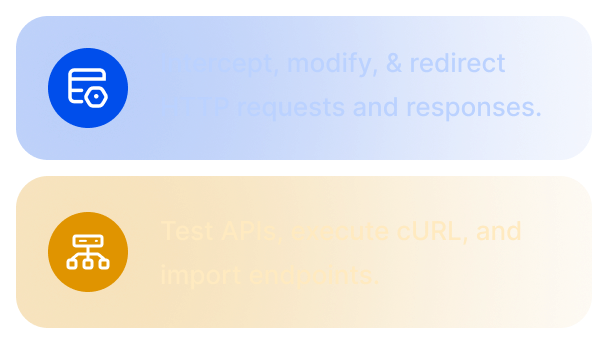10 must-have backend development tools
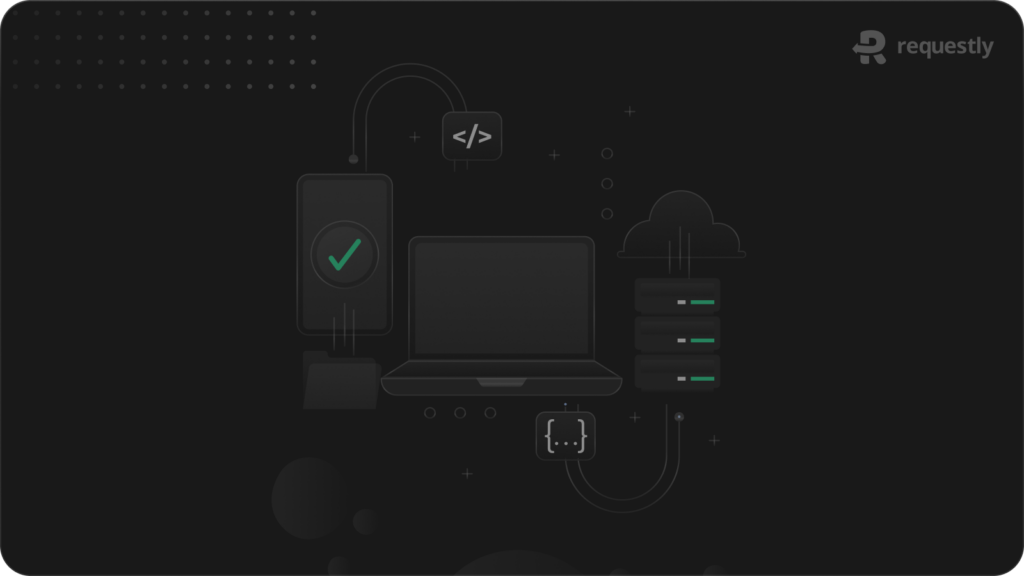
Backend development is one of the components of web development. Every developer has their toolset for development. This article will cover the best backend development tools, that can help you with the smooth development process.
We cover the best backend development tools for different development processes and categorize them in Framework, API testing, and Hosting. Let’s jump into it.
Framework - Backend Development Tools
Nitric
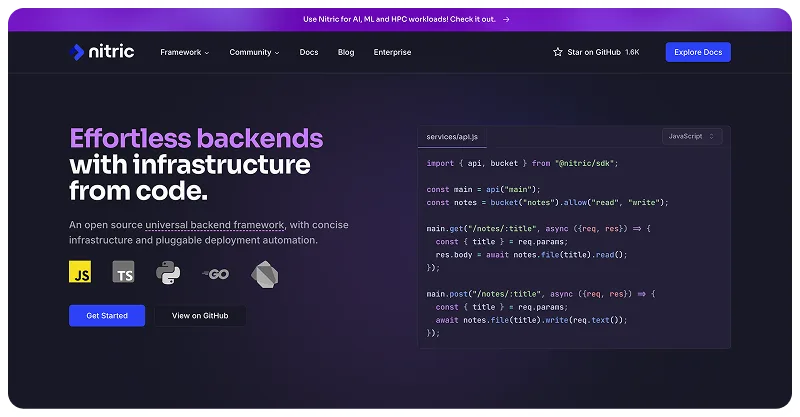
An open source universal backend framework. Nitric is a multi-language backend framework that lets you declare infrastructure requirements in code for common cloud resources and provides a convenient interface to interact with them.
Main Features
- Run locally: Fine tune your application offline from your first commit. Prototype, develop, and test your application without incurring cloud costs.
- Convenient APIs: Common tasks should be intuitive and easy, without limiting fine-grained control when you need it.
- Automation plugins: Use existing nitric plugins or build your own. Nitric enhances automation tools like Terraform, Pulumi, and more.
Pros
- Nitric has built-in runtime and deployment plugins for major cloud providers or build your own for any platform.
- Nitric provides plugins for AWS, Azure, and Google Cloud out of the box, then extend or build your own when things get custom.
- Develop and deploy faster by running your apps locally in simulated cloud environments.
- Nitric integrates with existing tools and pipelines to enhance quality, security & automation.
Cons
- Less community support
Pricing
- Free
Prisma
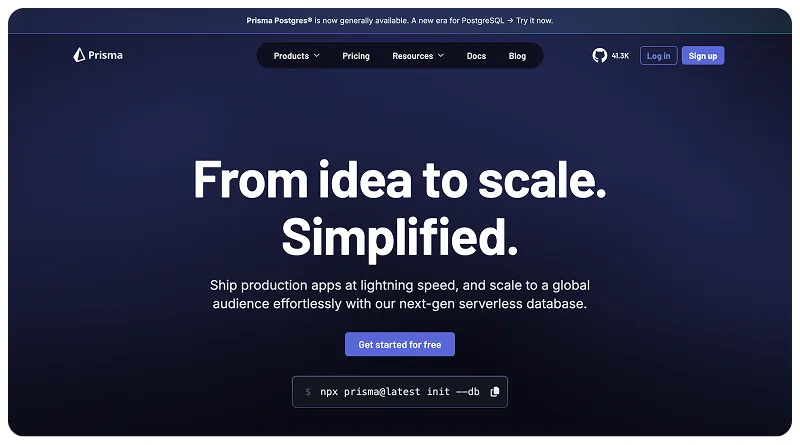
Prisma is an open-source Object-Relational Mapping (ORM) tool primarily used in backend development, particularly with Node.js and TypeScript, that simplifies database interactions by providing a user-friendly way to define data models and generate type-safe queries, eliminating the need to write complex SQL code directly.
Main Features
- Data Modeling with Prisma Schema: Developers define their database schema using a dedicated language within a “schema.prisma” file, describing the relationships between different data models.
- Auto-generated Prisma Client: Auto-generated and type-safe query builder for Node.js & TypeScript.
- Migrations: Prisma Migrate helps manage database changes by generating migration files that reflect schema updates, ensuring data consistency across deployments.
- Prisma Studio: GUI to view and edit data in your database. Prisma Studio is the only part of Prisma ORM that is not open source. You can only run Prisma Studio locally.
Pros
- Type-safe queries generated by Prisma help catch potential errors early in the development process.
- By handling much of the database interaction logic, Prisma allows developers to focus on core application logic, reducing boilerplate code.
- Prisma supports a wide range of databases including PostgreSQL, MySQL, SQLite, MongoDB, and more.
Cons
- It’s quite new in the market. Few complaints have been logged yet, but the most concerning query of Prisma is handling errors with a large number of databases.
Pricing
- Starter: Free
- Pro: $49/month
- Business: $129/month
Encore

Encore is an Open-Source framework designed to build robust distributed systems with features like APIs, microservices, databases, and queues.
Main Features
- Backend focus: While you can technically host a frontend using Encore, it’s not its primary purpose and most recommend deploying your frontend on dedicated services like Vercel or Netlify for production.
- Type-safe: Encore promotes type safety in your backend code, which can improve development efficiency and reduce errors.
- Distributed systems: Encore is specifically designed to build complex, scalable backend systems with features for managing distributed components.
Pros
- Leverages TypeScript for robust type checking, leading to fewer runtime errors and improved code maintainability.
- Utilizes a Rust-based backend for excellent performance and scalability, especially in high-traffic scenarios.
- Built with cloud-native principles in mind, enabling seamless integration with various cloud providers.
- Streamlines the process of managing cloud infrastructure by automatically provisioning and managing resources based on your application’s needs.
- Allows developers to define infrastructure requirements in a simple, declarative manner, making code easier to read and understand.
Cons
- Due to its unique architecture and features, Encore might have a steeper learning curve for developers unfamiliar with Rust or advanced TypeScript concepts.
- Compared to more established backend frameworks, the Encore community is relatively smaller, potentially limiting available support and resources.
- For developers who need highly customized infrastructure configurations, the declarative approach of Encore might limit flexibility in certain scenarios.
- While growing, the ecosystem of available libraries and integrations for Encore might be smaller than other frameworks.
Pricing
- Free
- Pro: $39/user/month
Appwrite
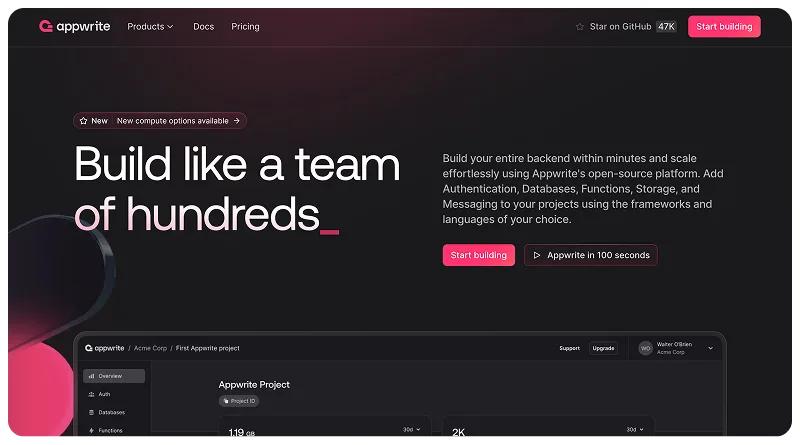
Appwrite is an end-to-end backend server for Web, Mobile, Native, or Backend apps packaged as a set of Docker microservices. Appwrite abstracts the complexity and repetitiveness required to build a modern backend API from scratch and allows you to build secure apps faster.
Main Features
- Auth: Authenticate users securely with multiple login methods, such as Email/Password, SMS, OAuth, anonymous, Magic URLs, and more.
- Databases: Scalable and robust database backed by your favorite technologies.
- Functions: Deploy and scale serverless functions in secure, isolated runtimes.
- Messaging: Set up a full-functioning messaging service for your application that covers multiple channels under one unified platform.
- Realtime: Subscribe and react to any Appwrite event using the Realtime API.
Pros
- Appwrite’s open-source code allows developers to modify and extend features to fit their specific project needs, offering more flexibility than other backend services.
- Allows for full control over the backend infrastructure by self-hosting Appwrite on your own servers, which can be beneficial for specific deployment needs.
- Appwrite offers secure file storage with built-in encryption and access controls, ensuring data protection.
- A growing community of developers actively contributes to Appwrite, providing support and driving ongoing development.
Cons
- Managing and maintaining your own Appwrite server can add operational complexity compared to using a fully managed backend service.
- The free tier of Appwrite may have usage limits on features like function executions, which could become restrictive for larger applications.
Pricing
- Free
- Pro: $15/month
- Scale: $599/month
- Enterprise: Contact sales
API Testing - Backend Development Tools
Requestly’s API Client

Requestly is a modern and powerful companion for API Development and Testing. It is an open-source tool purpose-built to speed up and simplify API development workflow for developers and QAs.
Main Features
- Cross-Platform Support: Available as both a web app and standalone app.
- Collections: Group and organize API requests for better workflow management.
- Environment Management: Seamlessly switch between development, staging, and production environments.
- Authorization Support: Manage authentication seamlessly with API keys, bearer tokens, and more.
- Dynamic Scripting: Use pre-request and post-response scripts to automate and modify requests/responses.
- Mock API Responses: Simulate responses for testing incomplete backends or edge cases.
- Collaboration: Share environments and collections with your team for seamless collaboration.
Pros
- Cross-platform flexibility (web app + standalone app).
- Intuitive interface with powerful debugging tools.
- Real-time collaboration with cloud sync.
- Open-source.
- Advanced interception capabilities to modify requests and responses dynamically.
Cons
- Limited advanced features compared to standalone clients.
Pricing
- Free
Postman
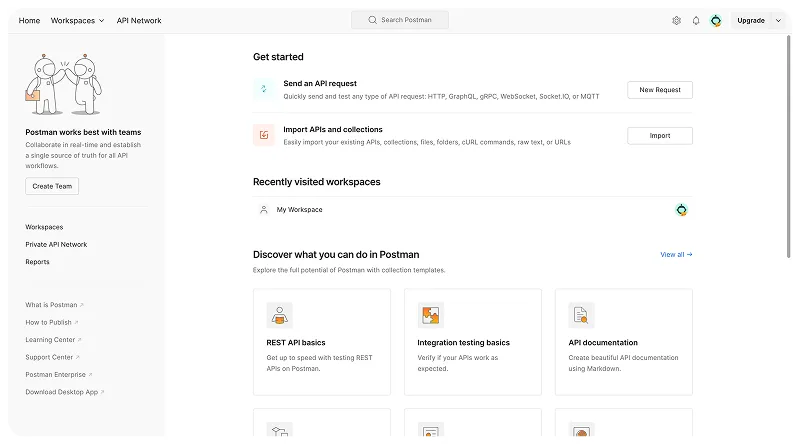
Postman is one of the most popular API clients, offering a comprehensive suite of tools for developers. It is designed to cater to both beginners and advanced users, providing features that streamline API development and testing. With its robust interface, Postman has become a standard tool in the API world.
Main Features
- Collections: Organize API requests into collections for better management.
- Automated Testing: Write and run tests using JavaScript.
- Environment Variables: Easily switch between development, staging, and production environments.
- API Documentation: Generate and share API documentation effortlessly.
Pros
- Extensive features for professional API workflows.
- Great for collaboration.
- Supports multiple API types.
Cons
- Heavy resource usage.
- Can feel overwhelming for beginners.
Pricing
- Free
- Pro: $14/user/month
- Scale: $29/user/month
- Enterprise: $49/user/month
Hosting - Backend Development Tools
Docker
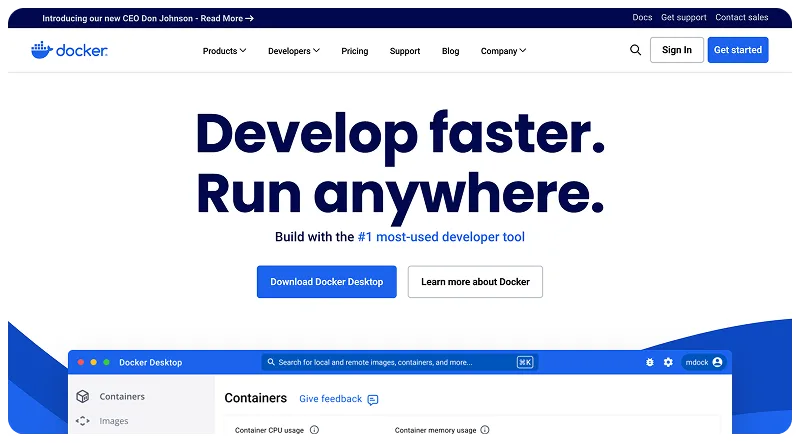
Docker is a free and open-source application containerization technology. Developers may swiftly deploy and scale apps across many environments using Docker containers.
Main Features
- Swarm: It is a Docker container clustering and scheduling tool. Swarm’s front end is the Docker API, which allows us to manipulate it with various devices and manage a cluster of Docker hosts as if they were a single virtual host. It is a self-organizing collection of engines that allows for pluggable backends.
- Mesh Routing: Incoming requests for published ports on accessible nodes are sent to an active container. This feature establishes the connection even if no tasks are executed on the node.
- Security: It enables us to store secrets in the swarm and then pick which services have access to which secrets.
Pros
- Each program is isolated from the others.
Cons
- Managing many containers can be complicated.
- Docker does not provide cross-platform compatibility, which implies that if an application is built to run in a Docker container on Windows, it will not operate in a Docker container on Linux.
Pricing
- Free
- Pro: $5/month
- Team: $7/month
- Business: $21/month
Kubernetes
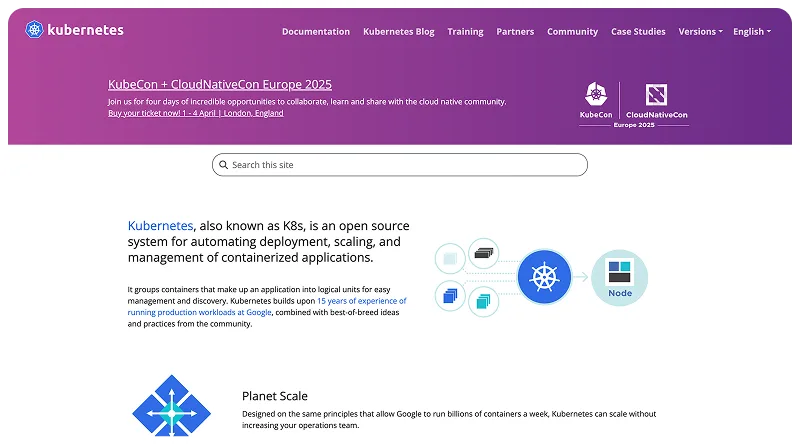
Kubernetes (K8s) is an open-source container orchestration technology that can launch, scale, and manage contemporary online applications. It groups application containers into logical units to facilitate discovery and administration.
Main Features
- Bin packing is done automatically: Automatically scales each container depending on defined metrics and available resources.
- Load balancing and service discovery: It defaults to containers with their DNS names and IP addresses. It also allows for load balancing during traffic surges to maintain stability.
- Self-monitoring: Kubernetes performs health checks on your applications to identify and prevent potential problems.
- Storage management: It mounts your preferred storage system to reduce latency and improve user experience.
- Capabilities for self-healing: Improves application performance by monitoring and replacing unhealthy containers.
Pros
- Kubernetes can help reduce infrastructure costs by optimizing the use of hardware and cloud investments.
- Kubernetes can help businesses scale and improve microservices performance.
- Automation can speed up deployment, reduce human errors, and ensure consistent configuration.
- Kubernetes can enable infrastructure to self-heal, which can help ensure reliable operation.
Cons
- Delays in managing containers can affect application performance.
Pricing
- Free
Vercel
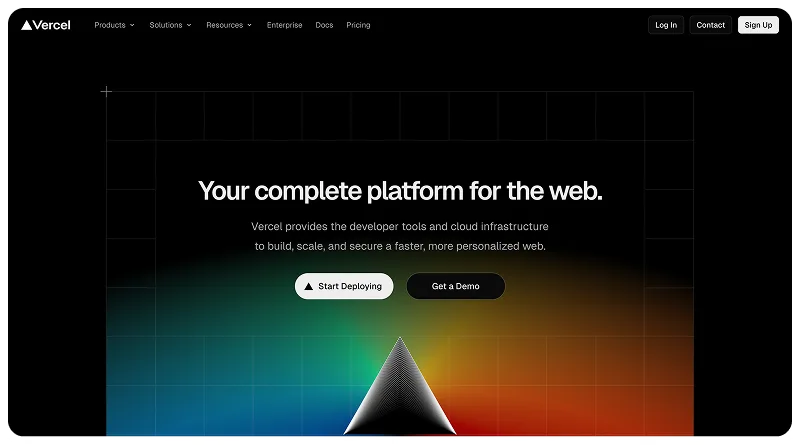
Vercel is a cloud platform that helps developers build and deploy web applications. It’s designed to simplify the process of hosting, scaling, and deploying web apps. If you’re building a NextJS application and you’re looking for a quick way to deploy it, then there is probably no better place than Vercel (the owner of NextJS).
Main Features
- Fluid compute: combines the efficiency of servers and the flexibility of serverless, enabling real-time, dynamic workloads like APIs, streaming, and AI.
- Rendering: Manage Global rendering for dynamic web apps.
- Observability: Detect and diagnose issues in your web applications by surfacing errors, traffic, and performance data with built-in Monitoring.
Pros
- Automatically updates your web app after each code commit.
- Helps multiple teams work together on projects.
- Automatically scales to meet traffic fluctuations.
- Globally distributed infrastructure reduces latency and speeds up loading times.
Cons
- Limited features in Free plan.
Pricing
- Hobby: Free
- Pro: $20/month
- Enterprise: Contact sales
Nhost

Nhost is an open-source backend and development platform that streamlines backend development by providing a comprehensive suite of tools and services. It enables developers to build and scale web and mobile applications efficiently, focusing on delivering robust features without the complexity of managing backend infrastructure.
Main Features
- PostgreSQL Database: Utilize the world’s most advanced relational database for reliable and scalable data storage.
- GraphQL API: Access an instant, real-time GraphQL API based on your database schema, facilitating seamless data interactions.
- Authentication: Implement role-based permissions and authentication mechanisms to secure your applications effectively.
Pros
- Easy to set up and configure.
- Nhost automatically creates RESTful APIs for your data model, simplifying frontend integration.
- Can scale to handle increasing traffic with minimal configuration changes due to its cloud-based architecture.
- Provides access to the source code, allowing for greater transparency and potential customization.
Cons
- Relying on Nhost’s infrastructure could lead to challenges migrating to another backend solution in the future.
- Depending on usage, the pricing model could become expensive for large applications.
- Understanding the Nhost data model and its functionalities may require some learning time.
Pricing
- Starter: Free
- Pro: $25/month
- Team: $599/month
- Enterprise: Contact sales
Conclusion
Choosing the right backend development tools can significantly enhance your development workflow, boost productivity, and ensure your applications are robust, scalable, and secure.
Whether you’re building microservices, testing APIs, or managing containers, these trending backend development tools can help you build faster, smarter, and more efficiently. Stay ahead in backend development by experimenting with these tools and incorporating the best fit into your tech stack.
Also, If you are looking for tools for frontend development. You can check out the article for best tools for web development in 2025. We have listed various tools that can help you to increase your productivity.
Contents
Subscribe for latest updates
Share this article
Related posts



















